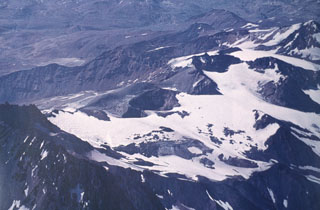Report on Planchon-Peteroa (Chile) — 30 January-5 February 2019
Smithsonian Institution / US Geological Survey
Weekly Volcanic Activity Report, 30 January-5 February 2019
Managing Editor: Sally Sennert.
Please cite this report as:
Global Volcanism Program, 2019. Report on Planchon-Peteroa (Chile) (Sennert, S, ed.). Weekly Volcanic Activity Report, 30 January-5 February 2019. Smithsonian Institution and US Geological Survey.
Planchon-Peteroa
Chile
35.223°S, 70.568°W; summit elev. 3977 m
All times are local (unless otherwise noted)
Observatorio Volcanológico de los Andes del Sur (OVDAS)-SERNAGEOMIN and ONEMI reported an increase in ash emissions at Planchón-Peteroa beginning at 1700 on 1 February, with ash plumes rising as high as 2 km and drifting E. This activity was accompanied by the appearance of discrete, very-low-frequency seismic events which were only recorded that day. On 3 February webcams showed gas-and-ash plumes rising to heights less than 2 km. The Alert Level remained at Yellow (the middle level on a three-color scale) for the volcano, and ONEMI maintained Alert Level Yellow for the communities of Molina (66 WNW), Curicó (68 km NW), Romeral (75 km NW), and Teno (68 km NW).
Geological Summary. Planchón-Peteroa is an elongated complex volcano along the Chile-Argentina border with several overlapping calderas. Activity began in the Pleistocene with construction of the basaltic-andesite to dacitic Volcán Azufre, followed by formation of basaltic and basaltic-andesite Volcán Planchón, 6 km to the north. About 11,500 years ago, much of Azufre and part of Planchón collapsed, forming the massive Río Teno debris avalanche, which traveled 95 km to reach Chile's Central Valley. Subsequently, Volcán Planchón II was formed. The youngest volcano, andesitic and basaltic-andesite Volcán Peteroa, consists of scattered vents between Azufre and Planchón. Peteroa has been active into historical time and contains a small steaming crater lake. Historical eruptions from the complex have been dominantly explosive, although lava flows were erupted in 1837 and 1937.
Sources: Oficina Nacional de Emergencia-Ministerio del Interior (ONEMI), Servicio Nacional de Geología y Minería (SERNAGEOMIN)

